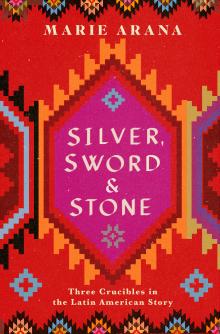
Silver, Sword, and Stone
With her new book, Silver, Sword, and Stone: Three Crucibles in the Latin American Story, Arana weaves a magnificent tapestry of historical research with up-to-the-minute reporting and cultural analysis to give readers an urgent look at Latin America today. Silver, Sword, and Stone is a brilliant, kaleidoscopic book. Its extraordinary sweep artfully and perceptively traverses a wide terrain of time and topics, showing readers how the past lives on today. “History has a way of slipping fitfully into the future,” writes Arana, and nowhere is that clearer than in the people she profiles. They are emblematic of three obsessions that have held Latin Americans fast for the past millennium:
Silver represents the lust for precious metals—a fixation that burned brightly before Columbus’ time, consumed Spain in its relentless conquest of America, drove a cruel system of slavery and colonial exploitation, sparked bloody revolutions, addled the region’s stability for centuries, and morphed into Latin America’s best hope for the future.
Sword is Latin America’s abiding propensity to solve problems by a culture of the strongman with unilateral and alarming displays of power, brutality, coercion, and an overweening love for dictators and the military: la mano dura, the iron fist.
With Stone, Arana addresses the region’s fervent adherence to religious institutions, whether they be temples, churches, elaborate cathedrals, or piles of sacred rock.
Ultimately, it is the people in Silver, Sword, and Stone, who tell us the most about the place. “Chroniclers of old have accustomed us to see history from the eye of the invader, from the perspective of conquest,” writes Arana. “We tend to think of the arc of these Americas as the story of Columbus and the Taíno. The story of Cortés and the Aztecs. Pizarro and the Incas. Cabeza de Vaca and the Guaraní. Spain and its colonies. The tinpot dictator and his unfortunate casualties. The Catholic Church and the pagans. The vast world economy and the coveted veins that lie dormant in the earth. Until we understand the ‘ands’ of history we cannot hope to understand the region as it is now." Though Leonor, Carlos, and Xavier will probably never meet, their stories are inextricably bound by the hemisphere’s history. Through them, Arana writes about the “ands” of today. In telling the history of Latin America—the region’s predilection for strongmen, the enduring role of the church and other indomitable institutions—Arana gives texture to the region’s relationship with Western cultures and illuminates both the modern border crisis and the North’s role in ensuring it goes on. Arana also warns readers that until Latin America and its neighbors understand how its people have been shaped, sharpened, and stunted by iniquities, the crucibles of silver, sword, and stone will continue to write its story.
Marie Arana

Marie Arana is a Peruvian-American author of nonfiction and fiction, senior advisor to the U.S. Librarian of Congress, director of the National Book Festival, the John W. Kluge Center’s Chair of the Cultures of the Countries of the South, and a Writer at Large for the Washington Post. For many years, she was editor-in-chief of the Washington Post’s literary section, Book World. She has also written for The New York Times, National Geographic, The International Herald Tribune, Spain’s El País, and Peru’s El Comercio, among many other publications. Her biography of Simón Bolívar won the 2014 Los Angeles Times Book Prize; her memoir, American Chica, was a finalist for the National Book Award; and she is also the author of two novels. Silver, Sword, and Stone is her newest book.
